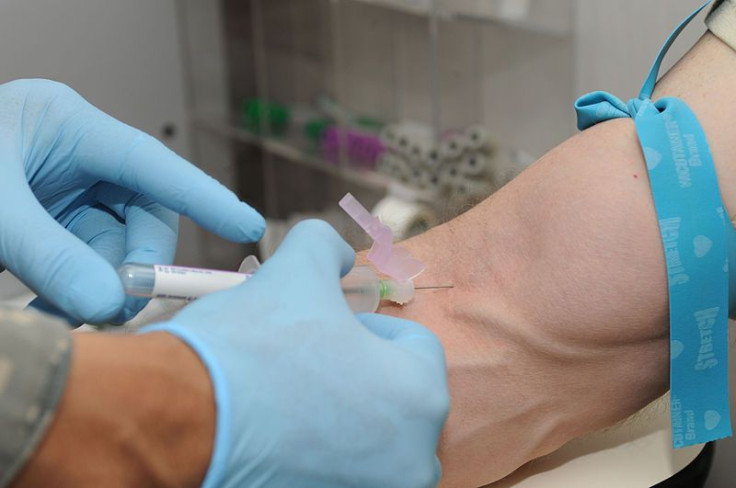Why Donating Blood Is Good For Your Health

It's time to roll up your sleeve and save a life — including yours.
Every two seconds, someone in the United States needs blood, with a total of 44,000 blood donations needed every day, reports the American Red Cross. One whole blood donation, which takes approximately 45 minutes to an hour, can come to the rescue of as many as three patients.
Harold Mendenhall, an 84-year-old lifetime blood donor from South Florida, donated his 100th gallon of blood, The Palm Beach Post reported. He started giving blood on July 7, 1977 when his wife, Frankie, was diagnosed with breast cancer. After she died, going to the blood bank was a way Mendenhall could deal with the grief of losing his wife and later his two sons. At least, he could save those who needed a blood transfusion.
Mendenhall, strong and healthy, donates 6 gallons of blood a year by platelets. In a platelet donation, a machine withdrawals the blood, filters out the platelets, and returns the rest of the blood to the donor, according to the Memorial Sloan-Kettering Cancer Center. This donation procedure takes 70 to 90 minutes and can be done once every seven days, allowing for the donor to give blood every few weeks instead of the eight weeks of waiting required for a non-platelet donation. Whole blood donors can also donate platelets 72 hours after a whole blood donation, and vice versa.
Blood donors must be 17 years old in most states, with some states lowering the limit to 16 years old with parental consent. Donors ages 16 to 18 are also subject to additional height and weight restrictions, says the New York Blood Center. A single individual who donates whole blood starting at 17 years old every 56 days until they reach 76 will have donated 48 gallons of blood, potentially saving more than 1,000 lives, says the American Red Cross.
While the health benefits of recipients who receive blood transfusions are clear, altruistic blood donors too, can reap the benefits.
Preserves Cardiovascular Health
Blood viscosity is known to be a unifying factor for the risk of cardiovascular disease, says the Harvard Medical School Family Health Guide. How thick and sticky your blood is and how much friction your blood creates through the blood vessels can determine how much damage is done to the cells lining your arteries. You can reduce your blood viscosity by donating blood on a regular basis, which eliminates the iron that may possibly oxidize in your blood. An increase in oxidative stress can be damaging to your cardiovascular system.
Blood donation reduces the risk of heart attacks and strokes, too. In a study published in the Journal of the American Medical Association (JAMA), researchers found that participants ages 43 to 61 had fewer heart attacks and strokes when they donated blood every six months. In a study published by the American Journal of Epidemiology, researchers found in a sample size of 2,682 men in Finland, those who donated blood a minimum of once a year had an 88 percent lower risk of heart attacks than those who did not donate.
The removal of oxidative iron from the body through blood donations means less iron oxidation and reduced cardiovascular diseases.
Reduces The Risk of Cancer
The reduction of iron stores and iron in the body while giving blood can reduce the risk of cancer. Iron has been thought of to increase free-radical damage in the body and has been linked to an increased risk of cancer and aging, says a study published in the Journal of the National Cancer Institute. Researchers followed 1,200 people split into groups of two over the course of 4 ½ years. One group reduced their iron stores by blood donations twice a year, whereas the other group did not make any changes. The results of the study showed that the group of blood donors had lower iron levels, and a lower risk of cancer and mortality.
The Miller-Keystone Blood Center says that the consistency of blood donations is associated with lower risks of cancers including liver, lung, colon, and throat cancers due to the reduction in oxidative stress when iron is released from the bloodstream.
Burns Calories
People burn approximately 650 calories per donation of one pint of blood, according to the University of California, San Diego. A donor who regularly donates blood can lose a significant amount of weight, but it should not be thought of as a weight loss plan by any means. To donate blood the American Red Cross requires donors to weigh at least 110 pounds and maintain healthy iron levels in the body.
Provides A Free Blood Analysis
Upon donation, donors are tested for syphilis, HIV, hepatitis, and other diseases. Testing indicates whether or not you are eligible to donate based on what is found in your bloodstream, says the American Red Cross. The organization also notes that a sample of your blood may be used now or in the future for additional tests and other medical research with your consent.



























